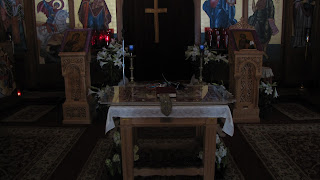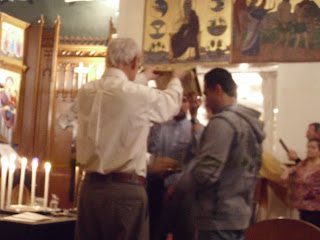Good Friday Vespers
"The noble Joseph, taking down thy most pure Body from the Tree,
wrapped it in clean linen and sweet spices and laid it in a new tomb.
But on the third day thou didst rise, O Lord, granting the world great mercy."
This afternoon, at Vespers, we remembered when Joseph of Arimathea asked Pilate if he could take Jesus' body down from the cross, so that He could be buried. Pilate agreed, and so Joseph took Jesus and buried him in his own, brand new tomb. (How generous!)
During the Gospel Reading, Fr. Edward Fr. Philip, took down the icon of Christ which had been placed on the cross in the center of the Church the night before.
Towards the end of the service, Fr. Edward takes a special cloth icon, called the Epitaphios, from the altar table. Four women then carry this cloth in a procession before placing it in the tomb in the center of the Church. The Epitaphios depicts Christ being prepared for burial.
The tomb and epitaphios will stay in the center of the Church for the remainder of Good Friday.






































.jpg)